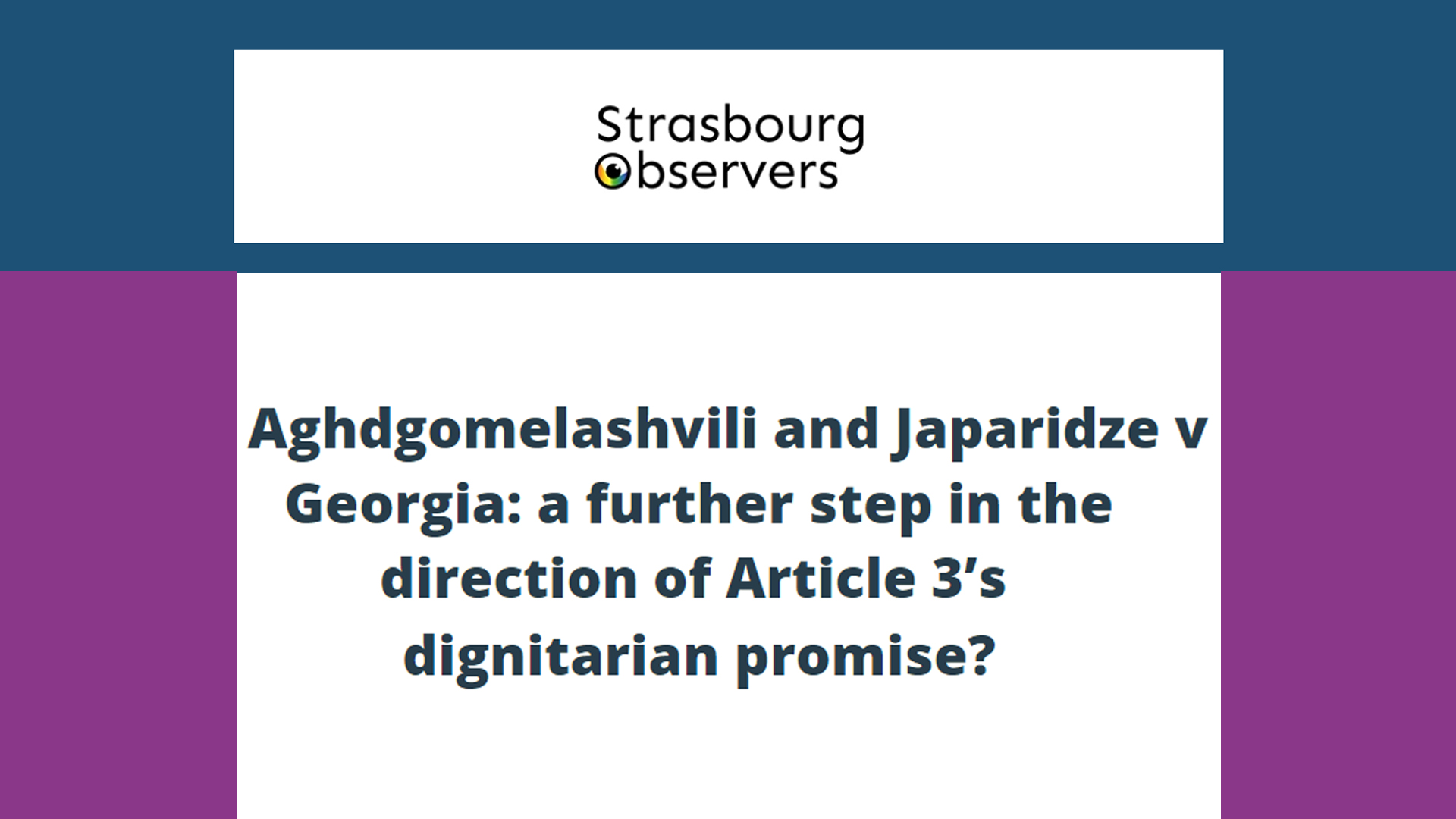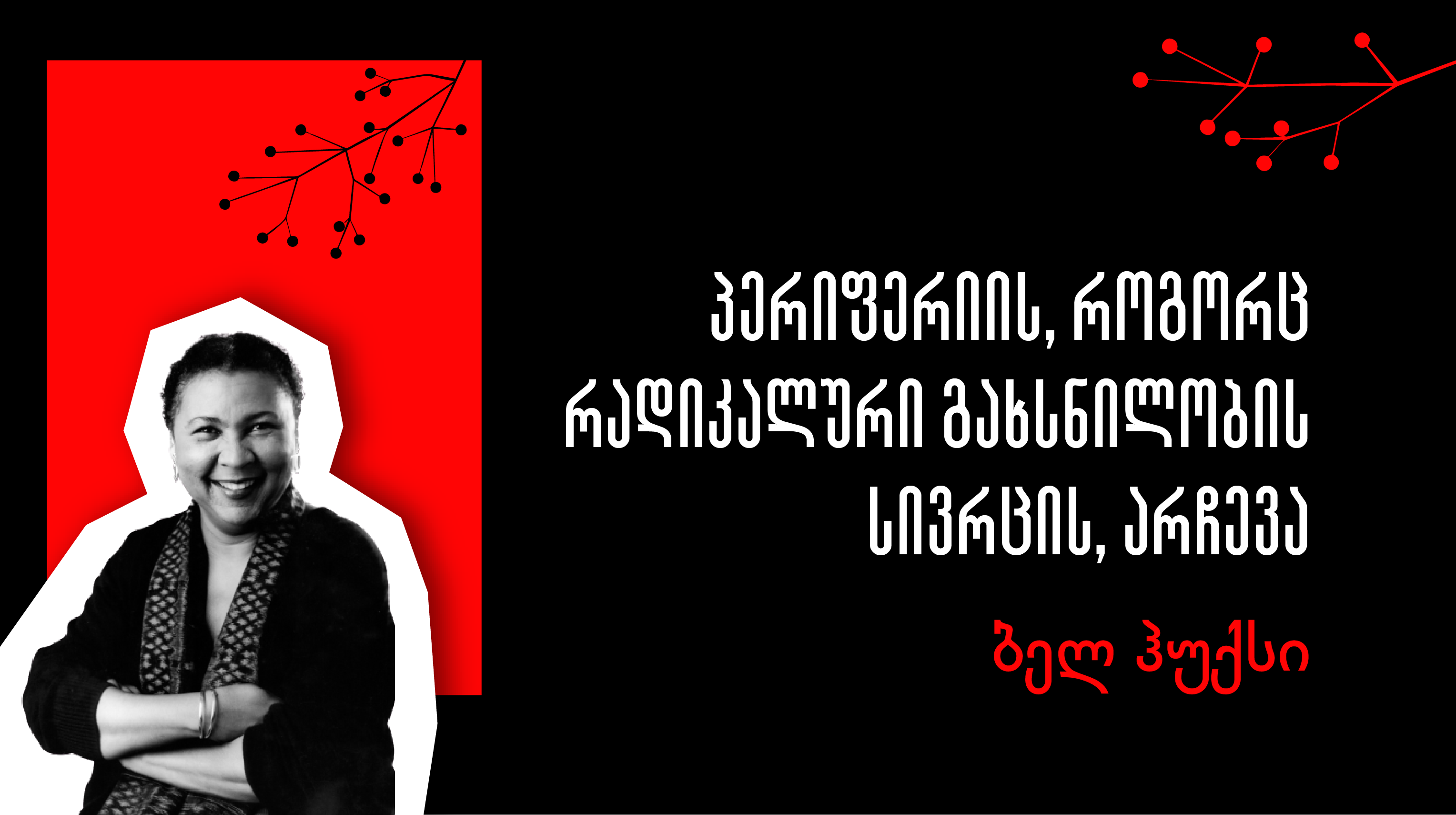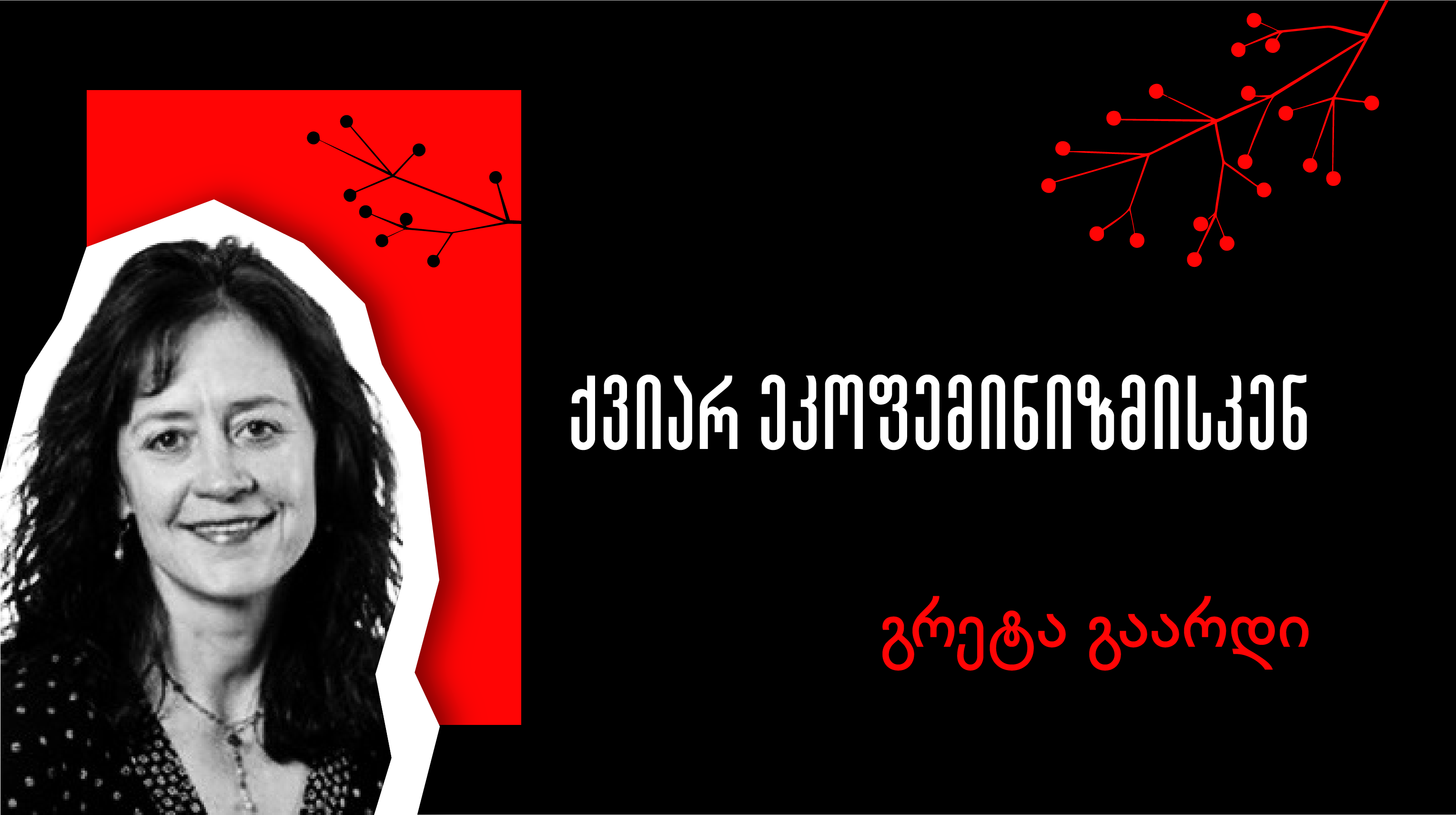By Natasa Mavronicola (University of Birmingham) and Laurens Lavrysen (Human Rights Centre, Ghent University)
On 8 October 2020, the European Court of Human Rights delivered a judgment in the case of Aghdgomelashvili and Japaridze v Georgia. The case concerns a police raid on the office of an LGBT organization in Tblisi. During this raid, police officers subjected the applicants to homophobic and transphobic insults, threats, and humiliating strip-searches. In its judgment, the Court found both a substantive and a procedural violation of Article 3 (the right not to be subjected to torture and inhuman or degrading treatment or punishment) in conjunction with Article 14 ECHR (prohibition of discrimination). The present contribution will first discuss the facts of the case and the Court’s judgment, before zooming in on the relationship between discrimination and Article 3. We conclude that the judgment constitutes a welcome step in cementing the nexus between discrimination and the wrongs proscribed by Article 3 ECHR, and the significance of this interconnection. We argue, however, that a more principled approach to the question of substantive violation of Article 3 would recognise as degrading any humiliating treatment with a discriminatory motive or intent.
The facts
The facts of the case, which were not disputed by the Government, are as follows. On 15 December 2009, around 6-7 p.m., 17 police officers in civilian clothing entered the office of the LGBT organization “Inclusive Foundation” . Both applicants were among the approximately ten women present there, making preparations for an art exhibition. No search warrant or any other judicial order was shown. The officers took the director of the organization to a separate room for questioning – he was later arrested when they found cannabis in his office – while isolating the women in the meeting room. When realizing that they were on the premises of an LGBT organization, the police officers became aggressive and started displaying homophobic behaviour, saying that they wished they could burn the place down, calling the women present “sick”, “perverts” and “dykes”, and threatening to reveal their sexual orientation to the public and to hurt their family members. They did not isolate a male-to-female transsexual person, but, confused about her gender, asked her whether the women in the meeting room were interested in men at all.
At about 10:30 p.m., the police officers announced that the women would be strip-searched. Nearly all of the women present were strip-searched by female officers in the office toilet. They were required to take off their clothes and some even their underwear, while being subjected to denigrating remarks such as “dykes”. No record of these searches was drawn up. According to the women concerned, it was evident that the measure had been carried out purely to humiliate them, since the officers did not even search the clothes they had taken off. They were released at about 11:30 p.m.
The applicants filed a criminal complaint for police abuse in January 2010, which is still pending. More than ten years later, no apparent measures in investigating the complaint have been taken nor did the applicants ever receive any reply to their request to be granted victim status. They brought proceedings before the ECtHR alleging ‘discriminatory ill-treatment by the police (on the grounds of their actual and/or perceived sexual orientation and gender identity)’ and the ‘absence of an effective domestic investigation capable of, amongst other things, unmasking the role which homophobic and/or transphobic motives played in the ill-treatment’ (§ 1).
The judgment
The Court begins its analysis by considering that, in the light of the circumstances of the case – in particular the homophobic and transphobic overtones of the abuse – it is most appropriate for the Court to conduct “a simultaneous dual examination under Article 3 taken in conjunction with Article 14 of the Convention” (§ 36), an approach previously adopted in Identoba and others v Georgia in 2015.
The Court first examines the case through the procedural limb of Article 3 in conjunction with Article 14, which imposes an obligation on State authorities, when investigating violent incidents, “to take all reasonable steps to unmask possible discriminatory motives” (§ 38). Given the protracted nature of the investigation, and the failure of the government to demonstrate that a single investigative measure had been undertaken in practice – against the background of “the well-documented hostility against the LGBT community in the country at the material time”, which made the need for such an investigation even more pressing – the Court easily made a finding of a procedural violation of Article 3 in conjunction with Article 14 (§ 40-41).
Turning to the substantive limb, the Court considers that “two interrelated questions are to be answered”:
“(i) whether or not the impugned acts of the police officers reached the requisite threshold of severity to fall within the ambit of treatment proscribed by Article 3 taken in conjunction with Article 14 of the Convention; and (ii) whether or not homophobic and/or transphobic hatred was a causal factor in the impugned conduct of the police officers […].” (§ 46)
The Court then states that it “has no hesitation in answering both questions in the affirmative” (§ 47), given the fact that: 1) the police officers had willfully humiliated and debased the women by resorting to hate speech and uttering insults; 2) their behaviour contained elements of threat, in particular to divulge their actual and/or perceived sexual orientation – in a country in which the LGBT community found itself in a precarious situation – as well as a threat to use physical force; and 3) the sole purpose of the strip-searches “was to make the applicants and the other women feel embarrassed and humiliated and thus punish them for their association with the LGBT community” (§ 48).
According to the Court, it was thereby established “that the wholly inappropriate conduct of the police officers […] was motivated by homophobic and/or transphobic hatred and must necessarily have aroused in the applicants feelings of fear, anguish and insecurity which were not compatible with respect for their human dignity” (§ 49). Such conduct “reached the threshold of severity within the meaning of Article 3 taken in conjunction with Article 14”, resulting in a violation of the substantive limb of these provisions (§ 49-50).
The ill-treatment – discrimination nexus
In this comment, we argue that the case of Aghdgomelashvili and Japaridze v. Georgia indicates a strengthening of the nexus between ill-treatment and discrimination under the Convention. We propose that, under a principled interpretation of Article 3 (alone and/or in conjunction with Article 14), a logical next step for the Court would be to recognize the autonomous character of an absolute prohibition on law-enforcement officers to humiliate individuals for discriminatory purposes without the further need to establish a certain “threshold” or quantum of suffering inflicted.
The case of Aghdgomelashvili and Japaridze v. Georgia builds on Identoba and others v Georgia, where the ECtHR had underlined the State’s positive obligations to “prevent hatred-motivated violence” (§ 63). In that case, the Court adopted a “dual” examination of the compatibility of protective measures against, and investigations into, hate-based violence with Article 3 and Article 14. It indicated that participants in an LGBT march were in a vulnerable situation warranting “heightened” protection (§ 72), and that the investigation into their allegations of homophobic and transphobic ill-treatment should unmask hate-based motives; otherwise, according to the Court, “prejudice-motivated crimes would unavoidably be treated on an equal footing with ordinary cases without such overtones, and the resultant indifference would be tantamount to official acquiescence to or even connivance with hate crimes” (§ 77). The ECtHR in Identoba found that the State had violated both its protective and its investigative duties.
Aghdgomelashvili and Japaridze v. Georgia brings this reasoning into the delineation of the State’s negative obligation not to torture or ill-treat. It reflects the ECtHR’s growing “appetite” for dual examination of Art.3 and 14 complaints, cements the nexus between the two, and marks significant progress since the dismissal of the Article 14 argument in the landmark case of Ireland v UK (in the context of the Article 5 complaint) and its disregard in other cases on Article 3 such as Denizci v Cyprus.
What we may distil from the Court’s position as stated in Aghdgomelashvili and Japaridze v. Georgia, which builds on a growing body of jurisprudence, is that there are at least three ways in which discrimination is directly relevant to determining (the gravity of) violations of Article 3 ECHR:
1) Discrimination may aggravate a particular treatment. This may have the implication of making the treatment reach the Article 3 ‘threshold’. This appears to be, at least in part, the case in Aghdgomelashvili and Japaridze . Alternatively, discrimination may aggravate ill-treatment that would already be considered to be incompatible with Article 3 ECHR, but the ECtHR wants this acknowledged and addressed, arguably in recognition of the expressive and/or symbolic function of underlining the augmented gravity of ill-treatment driven by prejudice. As the Court put it in Aghdgomelashvili and Japaridze, “treating violence and brutality with discriminatory intent, irrespective of whether they are perpetrated by State agents or private individuals, on an equal footing with cases that have no such overtones would be to turn a blind eye to the specific nature of acts that are particularly destructive of fundamental rights” (§ 44). Finally, and in line with the definition of torture found in Article 1 of the UN Convention Against Torture, a discriminatory motive or purpose may render ill-treatment severe enough to constitute torture (though there are, to our knowledge, no explicit findings of this by the ECtHR).
2) A context of discrimination may enlarge the protective positive obligations on the State, and require “heightened protection” (Identoba) under Article 3 ECHR.
3) Finally, discrimination in the State’s discharge of positive obligations, or failure to acknowledge it or seek to determine it in the discharge of the investigative obligation, may entail a violation of positive obligations in violation of Article 3 and 14 ECHR. The latter was notably the case in Identoba and similar findings have been made in a growing body of case law regarding failings in unmasking a discriminatory motive. Discrimination – or “large-scale structural bias” (Volodina v Russia, § 144) – has been found by the ECtHR to attach to shortcomings in protective measures in cases concerning domestic violence such as Opuz v Turkey, Talpis v Italy and Volodina v Russia; see also the Court’s findings in respect of a religiously motivated attack in Members of the Gldani Congregation of Jehovah’s Witnesses v Georgia.
An absolute prohibition on humiliations or threats with discriminatory purposes or motives
Despite the fact that the Court accepts, in principle, that ill-treatment does not necessarily require physical acts (e.g. Ireland v. the United Kingdom, § 167), the present case is nonetheless one of the rare cases in which the Court indicates with a degree of force that verbal abuse can amount to ill-treatment even irrespective of physical contact. In particular, the Court highlighted that the police
wilfully humiliated and debased the applicants, as well as their colleagues, by resorting to hate speech, by uttering insults such as “sick people”, “perverts” and “dykes” for everybody present in the office to hear. In addition to those personal insults against the applicants, the behaviour of certain police officers also contained elements of threat. The officers grossly mistreated the people gathered in the IF office, including the two applicants, – who all belonged to the LGBT community which found itself in a precarious situation in the country at the material time […] – by promising to divulge their actual and/or perceived sexual orientation to the public and by saying that they were on the brink of resorting to physical violence against them. The threat to use physical force was followed by one of the police officers saying that he wished he could burn the place down.
In the present case, the threat of physical ill-treatment contributed to the finding of a violation of Article 3, alongside the homophobic and transphobic humiliation and debasement of the applicants through both verbal abuse and a strip search aimed at humiliating and intimidating them. Of course, it is notoriously difficult to pinpoint the independent contribution of a single factor in a case in which the Court mentions various elements that in combination attain Article 3’s “minimum level of severity” threshold. However, reading the judgment, we may extrapolate that the humiliating and debasing treatment, inflicted with homophobic and/or transphobic intent, may in itself have been sufficient for the Court to find a violation of Article 3, regardless of the threat of further violence. The case is indicative of a principled approach that holds that humiliation and verbal abuse of individuals for discriminatory purposes or on the basis of discriminatory motives by law-enforcement personnel as such violates Article 3.
The significance of discrimination as an affront to human dignity that may itself violate Article 3 ECHR has been attested in other case law – notably in the East African Asians case, in which the European Commission of Human Rights, specifically with regards to racial discrimination, famously held that such discrimination “could, in certain circumstances, of itself amount to degrading treatment within the meaning of Article 3 of the Convention” (§ 196). According to the Commission, this is because “publicly to single out a group of persons for differential treatment on the basis of race might, in certain circumstances, constitute a special form of affront to human dignity” (§ 207, emphasis added). The European Court of Human Rights made reference to these statements in Cyprus v Turkey in 2001, before finding that the discriminatory treatment of enclaved Greek-Cypriots in the Turkish-occupied part of Cyprus, which could “only be explained in terms of…their ethnic origin, race and religion”, reached the “level of severity which amounted to degrading treatment” (§§ 309-310).
Article 3’s egalitarian underpinnings are duly recognized in such case law, and warrant further affirmation and application in concrete situations. Article 3 proscribes wrongs against human dignity: the gravest, torture, paradigmatically involves an ‘undoing’ of ‘the human standing of the victim’ (Bernstein 2015), a setting apart from humanity that is antithetical to the equal and elevated moral status of all human persons that human dignity represents (Mavronicola 2021). Moreover, Article 3’s absolute character is egalitarian by virtue of its unconditionality: it protects everyone irrespective of who they are, where they are from, or what they have done. In this regard, a more express interpretation of Article 3 in future case law as encompassing an absolute prohibition on humiliation for discriminatory purposes or driven by discriminatory motives, would align with a principled reading of Article 3, in line with its egalitarian underpinning.
In the general principles section of the present judgment (§ 42), the Court refers to the passage from the Bouyid judgment (§ 101) in which the Court held that “any conduct by law-enforcement officers vis-à-vis an individual which diminishes human dignity constitutes a violation of Article 3” and in which it specified that such conduct (i.e. a slap in the face in Bouyid). .This is important in clarifying that the Article 3 “threshold” is not strictly a matter of a particular quantum of suffering or tangible harm (whose quantification in and of itself is questionable – see also this blog post on prisoner cases), and can be reached by treatment whose severity lies in its incompatibility with human dignity. Indeed cases like Bouyid and Aghdgomelashvili and Japaridze illustrate the severity of expressive harm: such harm is not reflected in physical pain, injury or other forms of grave suffering necessarily, but rather in the message such treatment conveys regarding the status of the ‘Other’. Unfortunately, in the application of these principles, the Court does not wholly live up to the ‘dignitarian promise’of the Bouyid judgment, by still placing emphasis on the (presumed) “all-things-considered” impact of the ill-treatment on its victims (notably their fear and anguish), rather than expressly finding that the affront to human dignity constituted by the discriminatory humiliation and debasement of the applicants in and of itself violated Article 3.
Nonetheless, the ‘hardening’ of the anti-discrimination standard in Article 3 cases is an important development that should be celebrated and embraced. The nexus between Article 3 and Article 14 ECHR is important not just in shaping the negative obligation not to torture or ill-treat, as in the present case, but also in delineating positive obligations under Article 3 ECHR. There is no room for discrimination in States’ discharge of their positive obligations. As the Court underlines in Aghdgomelashvili and Japaridze, States are duty bound “to secure the fundamental values enshrined in Article 3 without discrimination” (§ 35 – a point so far made in a handful of cases). The absolute, non-displaceable nature of this requirement can have important ramifications for the delimitation of positive obligations in respect of persons that governments all too often deem unworthy of key protections, not least migrants (or “aliens”, as they are often unfortunately labelled by the Court), prisoners, and many other ‘Others’.







